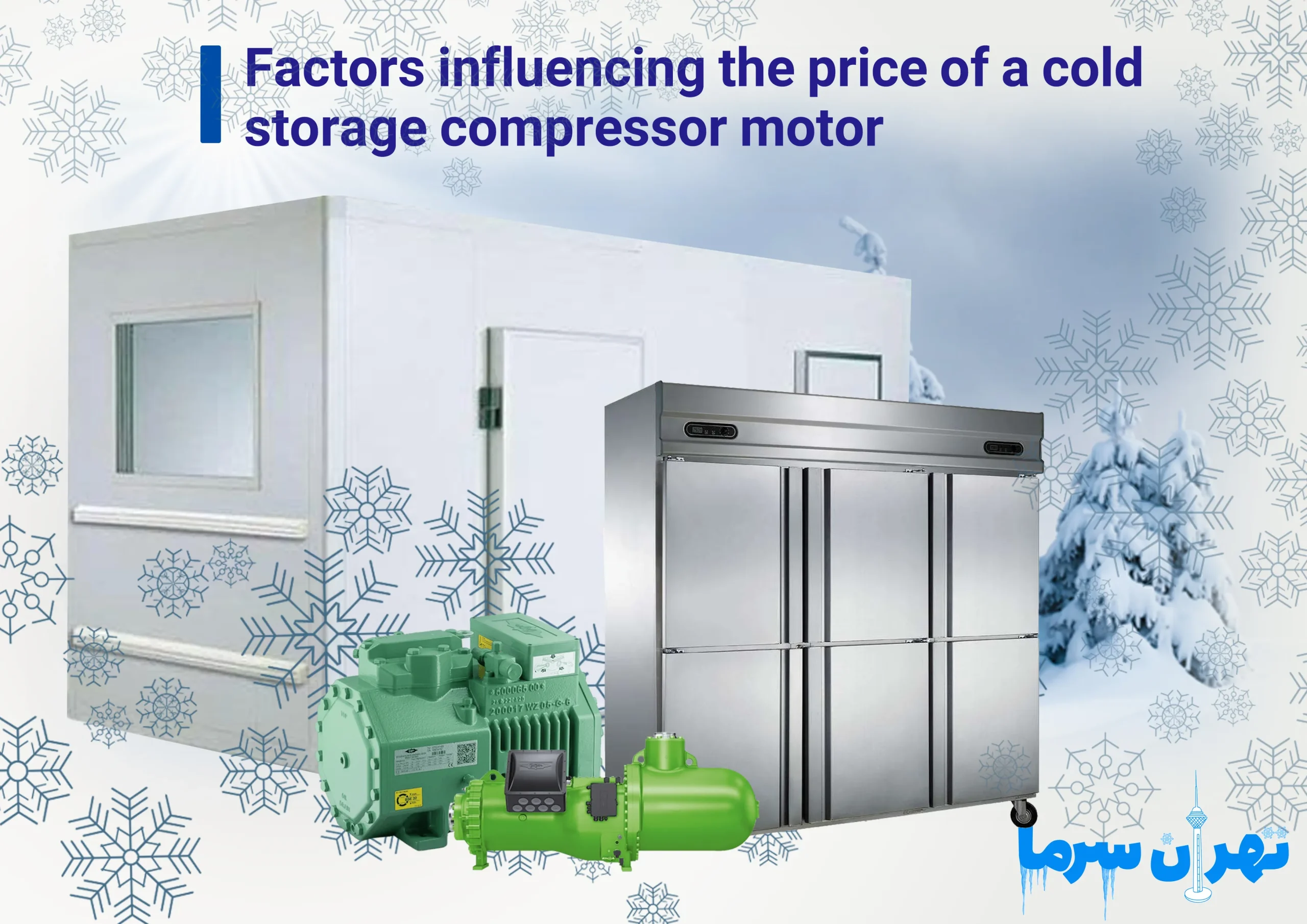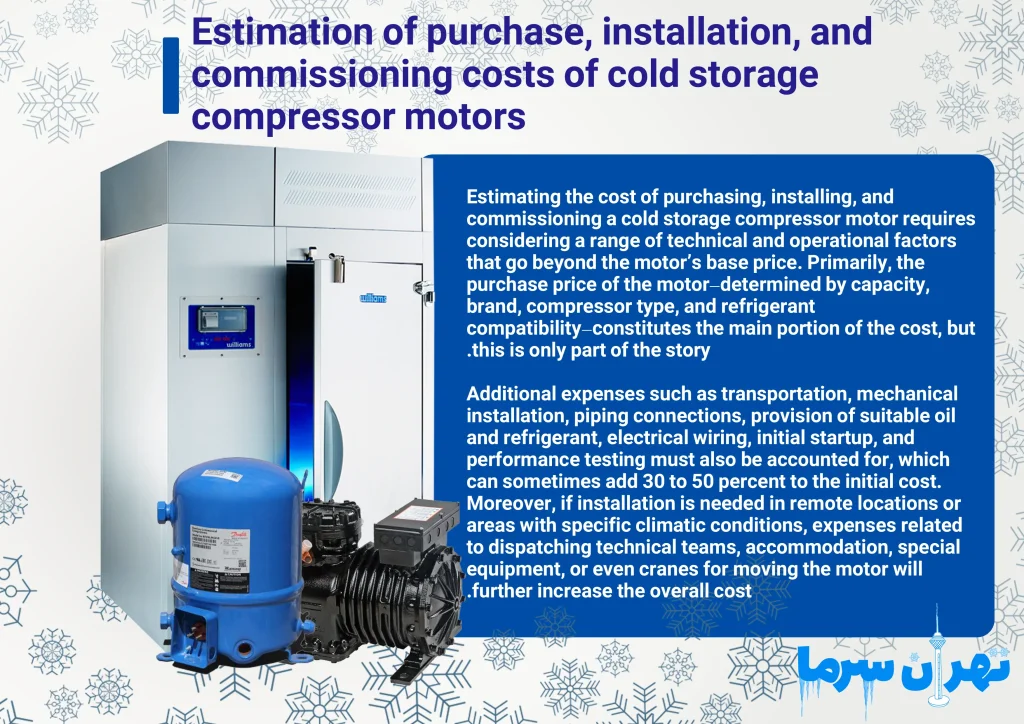Factors Influencing the Price of Cold Storage Motors in Tehran

The Price of Cold Storage Motors: Influencing Factors and Brand Comparison
The price of a cold storage motor is influenced by a combination of technical, economic, and branding factors, each of which can independently cause significant fluctuations in the market. Understanding these factors is crucial for buyers, contractors, and cold storage owners, as selecting the right motor not only ensures optimal system performance but also represents a sound economic investment.
One of the primary components affecting the price of a cold storage motor is the required cooling capacity. Motors designed for small cold rooms are lower in physical dimensions and power consumption, and naturally, they cost less compared to industrial and large-scale motors. As motor capacity increases, the technical design becomes more complex and requires more advanced technologies, which in turn raises the final price.
The type of compressor used in the motor also has a significant impact on pricing. Reciprocating, screw, and scroll compressors each have their own technical characteristics. Typically, screw compressors, used in larger projects, are more expensive due to their higher efficiency, longer lifespan, and greater work capacity. The choice of compressor depends not only on the project’s requirements but also on climatic conditions, thermal load, and the type of load in the cold storage.
Brand and manufacturing country play a crucial role in determining the cost of a cold storage motor. Brands like Bitzer, Copeland, Danfoss, and Frascold are always priced at the higher end due to high build quality, extensive technical support, and proven durability under various conditions. In contrast, lesser-known or Chinese brands, although cheaper, often face challenges in quality, efficiency, and after-sales service, which can lead to increased maintenance costs in the long run.
Another influential factor is the type of refrigerant the motor operates with. Certain refrigerants such as R404A or R134a, due to better environmental compatibility and higher efficiency, require specific designs and more durable components. Therefore, motors compatible with such refrigerants tend to be priced higher. Furthermore, alignment with environmental policies and greenhouse gas regulations in some countries also contributes to the popularity—and consequently, higher price—of some models.
Market conditions, supply and demand, currency exchange rate fluctuations, and access to spare parts also affect the final pricing of cold storage motors. Particularly in markets highly dependent on imports, exchange rates and customs costs can create considerable price differences. Hence, focusing solely on the numeric price when buying a cold storage motor is unwise; rather, a combination of criteria must be considered simultaneously to ensure a reliable choice both technically and economically.
Comparing Cold Storage Motor Prices Across Brand
Comparing cold storage motor prices across different brands is a key concern for professionals in the refrigeration industry, equipment vendors, technical consultants, and even cold storage project investors. Choosing a brand solely based on price may seem tempting at first, but in practice, it is a strategic and multifaceted decision that must be based on a clear understanding of the technical, performance, and economic differences between brands.
At the top of the global reputable brand list are Bitzer compressors from Germany, which have gained strong trust and popularity in Iran and other Middle Eastern countries. With precise engineering, high-quality materials, and top manufacturing standards, Bitzer offers high-efficiency products with long lifespans.
Naturally, these features result in higher prices for Bitzer cold storage motors compared to other brands. However, this price difference is often offset by reduced operational costs, lower energy consumption, and a reduced risk of long-term failures.
Alongside Bitzer, the American brand Copeland is another well-known name in the cold storage compressor market. Operated under Emerson, Copeland offers a wide range of capacities and models, extensively used in medium to large-scale projects. In terms of pricing, Copeland compressors generally fall below Bitzer, but due to their good quality, strong support, and global market presence, they are considered a reliable and cost-effective option.
Danfoss from Denmark, known more for its control equipment, valves, and thermostats, also holds a strong position in cold storage compressor manufacturing. Danfoss compressors are widely used in store cold rooms and industrial HVAC systems due to their compact design, acceptable performance, and compatibility with various refrigerants.
In terms of cost, Danfoss products are generally cheaper than Bitzer and sometimes more affordable than Copeland, making them a suitable choice for medium-budget projects.
In the lower price tiers, brands such as Frascold from Italy and Tecumseh from the USA are also notable. While Frascold compressors are more economical, they may fall short in durability and efficiency under harsh operating conditions or in large-scale projects.
Tecumseh focuses on small to mid-range compressors, making it a good fit for retail cold storage or residential refrigeration systems. However, a notable issue with these brands is limited after-sales service or spare parts availability in some markets, which must be considered before purchasing.
In recent years, Chinese and East Asian brands have entered international markets, offering cold storage motors at significantly lower prices. While these options have been used in temporary or low-budget projects, market experience shows that such low-cost motors, especially in sensitive or long-term projects, carry high risks. Common issues include poor build quality, lack of effective technical support, and incompatibility with some refrigerants.
Therefore, comparing cold storage motor prices across different brands requires a comprehensive analysis that goes beyond the final numeric cost. In addition to the purchase price, factors like service life, energy efficiency, after-sales service quality, spare parts availability, and performance stability under challenging conditions should be considered. A more expensive brand may incur higher upfront costs but can significantly reduce maintenance and repair expenses over the system’s lifespan. Thus, choosing a cold storage motor brand is a long-term technical decision that must be based on a clear understanding of the market, project requirements, and consultation with technical experts.
The Impact of Cold Storage Motor Capacity on Price
The capacity of a cold storage motor is one of the most crucial determinants of its price, with a direct and significant effect on the final purchase cost. Motor capacity, usually expressed in horsepower (HP) or kilowatts (kW), reflects the compressor’s ability to compress refrigerant gas and meet the cooling needs of the system.
This capacity must be correctly matched to the cold storage requirements. Any overestimation or underestimation in capacity selection not only disrupts system performance but also increases investment or operational costs.
Increased motor capacity naturally means larger compressor size, more complex construction, more raw materials, and higher energy consumption. High-capacity motors are typically used in industrial cold storages, freezing tunnels, or large-scale food storage centers. They require precise design, advanced control systems, and stronger auxiliary equipment. These technical complexities and the need for stable operation under high pressures result in significantly higher prices compared to smaller models.
On the other hand, lower-capacity motors used in retail, pharmaceutical, or residential cold rooms are simpler in design and thus more affordable. These motors are more energy-efficient, compact, and usually incur lower installation and startup costs. However, it must be noted that selecting a motor with lower-than-required capacity can lead to excessive strain, reduced service life, and inability to maintain the desired temperature. Conversely, oversizing leads to energy waste, high initial cost, and unstable performance.
Another key point is that the motor price is not determined solely by nominal capacity—it also depends on the technology used. For instance, two motors with the same rated capacity but different technologies (e.g., one screw and the other reciprocating) may have completely different prices. Therefore, decisions based solely on numeric capacity are not sufficient; other factors such as cooling load type, refrigerant type, local climate, and operational cycle must also be considered.
In summary, motor capacity plays a defining role in price, but it should not be evaluated in isolation from project needs. Optimal capacity selection should be based on precise cooling load calculations, type of stored product, air exchange rates, and even the architecture of the cold room. A well-chosen capacity enhances system longevity and efficiency while keeping long-term costs under control.
The Role of Refrigerant Type and Compatibility in Motor Pricing
The type of refrigerant used and the cold storage motor’s compatibility with it are significant technical and economic factors in determining the final price of compressors and motors. Each refrigerant has unique properties regarding working pressure, evaporation and condensation temperatures, toxicity, flammability, and environmental impact. The motor must be designed to operate safely and stably with a specific refrigerant.
Refrigerants like R404A, R134a, R407C, or R448A require compressors designed accordingly. Differences in chemical properties directly affect materials, gaskets, internal valves, and even the lubricant used in the motor.
Therefore, motors that operate with specific or eco-friendly refrigerants (such as HFOs or A2L-class gases) are usually more expensive due to the need for more advanced technologies and updated designs. Additionally, motors that support multiple refrigerants, known as multi-refrigerant, are valued more in the market for their flexibility.
Due to international regulations aimed at reducing ozone-depleting or high-global-warming refrigerants, motors compatible with newer, environmentally safer refrigerants are seeing price increases, especially in global markets. This is due to rising demand and the requirement to meet stricter manufacturing standards.
Estimating the Cost of Purchasing, Installing, and Commissioning a Cold Storage Motor
Estimating the cost of purchasing, installing, and commissioning a cold storage motor involves considering a range of technical and operational factors beyond the motor’s base price. Initially, the purchase cost—based on capacity, brand, compressor type, and refrigerant compatibility—makes up the primary portion of expenses, but it’s only part of the equation.
Additional costs include transportation, mechanical installation, piping connections, refrigerant and oil supply, electrical wiring, initial startup, and performance testing. These can add 30–50% to the base cost. If the installation site is remote or has specific climate conditions, costs for dispatching technicians, accommodation, special equipment, or even cranes for motor positioning may also apply.
In industrial projects, electrical panels, control systems, and sensors are essential parts of the setup that contribute significantly to the final cost. Furthermore, if the motor replaces an old system, additional expenses for retrofitting or modifying existing infrastructure may be incurred.
Thus, for accurate decision-making, one should not rely solely on the product’s list price. A comprehensive view of all project stages and requirements is needed to avoid hidden costs and potential delays.
Tehran Sarma, with years of experience in supplying, installing, and servicing refrigeration equipment, is recognized as a reputable provider of various cold storage motors. The company consistently aims to offer fair, transparent pricing tailored to different project needs.
With direct partnerships with reputable brands such as Bitzer, Danfoss, Copeland, and Frascold, Tehran Sarma provides access to a wide range of cold storage motors and helps customers choose the right product based on capacity, refrigerant type, and budget.
One of Tehran Sarma’s competitive advantages is providing accurate and realistic cost estimates from the initial purchase to final installation. This ensures customers can make a secure investment in refrigeration equipment without unexpected expenses.
You can contact Tehran Sarma’s team at +98 912 190 6418.




 سردخانه
سردخانه برق
برق کمپرسور
کمپرسور کمپرسور بیتزر
کمپرسور بیتزر کمپرسور کوپلند
کمپرسور کوپلند کمپرسور بوک
کمپرسور بوک کمپرسور دانفوس
کمپرسور دانفوس کمپرسور منیروپ دانفوس
کمپرسور منیروپ دانفوس کمپرسور امبراکو
کمپرسور امبراکو کمپرسور پاناسونیک
کمپرسور پاناسونیک کمپرسور سابکول
کمپرسور سابکول کمپرسور کوپلند
کمپرسور کوپلند کمپرسور اسکرال کوپلند
کمپرسور اسکرال کوپلند کمپرسورفراسکلد
کمپرسورفراسکلد کمپرسور رفکامپ
کمپرسور رفکامپ کمپرسور اسکرال دانفوس
کمپرسور اسکرال دانفوس گاز مبرد
گاز مبرد گاز R22
گاز R22 گاز R134
گاز R134 گاز R404
گاز R404 گاز R407
گاز R407 گاز R410
گاز R410 گاز R508
گاز R508 کندانسور هوایی
کندانسور هوایی اواپراتور
اواپراتور اواپراتور آرشه
اواپراتور آرشه اواپراتور صابکول
اواپراتور صابکول اواپراتور آسه
اواپراتور آسه اواپراتور نیک
اواپراتور نیک اواپراتور آرتک
اواپراتور آرتک اواپراتور نوین
اواپراتور نوین اواپراتور تبادل کار
اواپراتور تبادل کار درب
درب ساندویچ پنل
ساندویچ پنل فن سردخانه
فن سردخانه روغن کمپرسور سانیسو
روغن کمپرسور سانیسو متعلقات سردخانه
متعلقات سردخانه